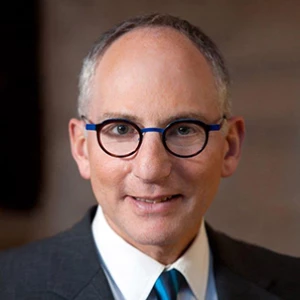For the CEO
This article was originally published in May 2016 and has been updated.
Let’s talk about energy—not the kind that heats your buildings and powers your facilities and servers, but the complex and powerful force that shapes organizational performance. CEOs can create, convey, and manage energy throughout an organization, making the difference between delivering high performance and missing targets.
By “energy,” we do not mean personality, passion, charisma, extroversion, cheerleading, or any of the other characteristics that are mistakenly attributed to it. Energy is related to—but different from—strategic focus, time management, and personal rituals, such as workouts and scheduled downtime. It is less about energetic action and more about
transferring alignment, conviction, capacity, and belief
to others in the organization.
Energy Starts at the Top
Energy operates as a two-way current that travels throughout an organization. Starting with the CEO, it reaches all the way to the front line—and even beyond, to outside stakeholders—through a series of face-to-face and increasingly virtual transmissions. Energy is how leaders receive feedback from both within and outside the organization. It is the byproduct of connectivity, preparation, intent, and self-awareness.
Energy is the byproduct of connectivity, preparation, intent, and self-awareness.
What’s more, energy is a palpable force. “I have learned … that the energy I brought to any situation was reflected and absorbed by the team,” one CEO said. “I have become more conscious of the power of my energy and more respectful of its effect on other people than I was before.”
CEOs must connect with, influence, and mobilize individuals who are often dispersed by thousands of miles. They must also engender enthusiasm, trust, and confidence among people who are sometimes more likely to trust their peers than their leaders.
But despite the importance of managing energy effectively, many leaders have so far focused on only part of the task: the sources of energy rather than its uses. The emphasis has been on working with the CEO to maintain proper health and wellness habits, set aside time for renewal and recharging, and apply athletic-training principles to executive development. These aspects of creating and managing energy are essential but require a complement: the broader and more powerful application of energy to initiate positive change. “As CEO, there is no such thing as throwing a pebble in the pond; everything you throw in the pond is a boulder,” one top executive told us.
To understand this critical but misunderstood concept, we interviewed 50 current and former CEOs of companies as varied as West Coast startups, Fortune 500 members, and nonprofit organizations. We also relied on hundreds of conversations with top leaders in our CEO Advisory program. Nearly all of them said that managing energy was one of the most critically important aspects of their jobs. Three dimensions of energy emerged from these interviews.
Energy Is Contagious
In every interaction, CEOs radiate energy. This energy can be positive or negative—and it doesn’t affect just the immediate recipient. Rather it amplifies across the organization through word of mouth and social media, ultimately rebounding to the CEO. A negative meeting with a CEO is rarely self-contained. As William Faulkner wrote, “The past is never dead. It’s not even past.”
Perceptive leaders can amplify their own influence and pick up on the energy levels within their companies. They understand when they need to convey intensity and when they need to be calm, because putting out too much energy can be wasteful and limit the contributions of others. They also draw strength from their teams and recognize when they need to adjust their approach. “I definitely get energy from rallying up my team and spending time making a human connection, not just a work connection,” one CEO said. As another business unit CEO wrote in an internal communications memo, “First and foremost, be a human.”
Conversely, displaying too little energy can zap an organization of motivation and set a negative tone. CEOs should be willing to display passion and enthusiasm, or they risk being viewed as difficult to know, distant, and disconnected.
The term “energy” can imply activity bordering on the hectic, but sometimes CEOs amplify energy by presenting a calm demeanor, especially during tough times. The CEO of a major financial services firm was deliberately calm during the global financial crisis, as a sign of strength for both employees and customers. “The ability to pull through that period separated us from a lot of our competitors,” he said. As another CEO said, “I look to be the thermostat [of my team’s energy], not the thermometer.”
Energy Is a Force for Value Creation
Positive energy creates employee engagement, alignment, and conviction. It instills self-confidence and a sense of purpose within the organization. Energy unleashes capacity and improves an organization’s ability to execute on strategy by tapping into people’s reserves of discretionary effort. By harnessing and channeling their reserves of personal energy, CEOs can create value in four ways.
Positive energy creates employee engagement, alignment, and conviction.
Encouraging Bolder Moves. CEOs can instill confidence in an organization. They can help people transition from fearing failure to taking prudent risks. As BCG’s founder said, “The most effective leaders are those who can inspire others to think beyond their limitations” and “believe in something bigger than themselves.”
People often are unwilling to deliver hard news to CEOs or overreact to their offhand comments. A CEO in touch with the energy in the room is alert to subtle clues and can offer encouragement.
Increasing Dynamism and Adaptability. CEOs who can channel their energy create positive momentum in the face of large challenges. Change often makes employees anxious. By breaking big initiatives into bite-sized tasks, CEOs and senior leaders can build momentum, positive energy, and excitement for the changes ahead.
Organizations will move faster and with greater certainty. They will also have a stronger ability to correct their course when, as inevitably happens, the original strategy needs revision.
Generating Greater Productivity. Energy is closely related to employee engagement, the willingness of people to commit discretionary effort to their jobs. When you walk into a high-performance organization, you can feel the difference. Instead of staring blankly at their screens or slouching in meetings, people are invigorated. They talk fluently about their organization’s mission and strategy. They are instilled with purpose; they know what they are supposed to be doing and how it relates to the tasks of their colleagues.
The CEO and senior leaders spark and convey energy to their direct reports, who then pass it down the line. “There’s a part that is visible. I call it ‘touch.’ You are with an individual or a group, and you can feel the engagement. You transfer the energy. I think it’s a visceral experience,” a CEO said.
Expanding Organizational Capacity. Energy can unlock latent capacity in an organization by creating a sense of urgency and expectation and by providing a laser-like focus on the most critical initiatives. Complexity and inertia start to fall away when employees are energized by a common purpose. “One of the primary responsibilities I have as CEO is to create a positive energy environment. Momentum and energy are related to having people motivated to achieve results,” one CEO told us.
Energy Needs to Be Gauged
CEOs need to understand whether they are transmitting the right level of energy—too much can be as damaging as too little—and receive feedback about the overall quality and level of energy in the organization. They also need to recognize when to pause and reflect and when to focus outward.
In other words, they need to measure the external perception of the energy they’re creating within their organizations. CEOs can get an overall sense of energy transmission in the organization through qualitative and quantitative feedback. But developing a real-time gauge of external perceptions can be challenging. CEOs gain insight by reading facial expressions, body language, and the nature of the questions that are asked. As one CEO said, “I think your actions as a CEO have more unintended consequences than most CEOs realize, both good and bad. You ask a question, and the next thing you know there are ten people running off doing things. And I just wanted to ask a question.”
Most CEOs we interviewed said that they also have a conscious handle on their internal energy. They create rituals and habits—such as exercise, spending time with family, prayer, and reading—to recharge. These practices help them to cultivate a measure of balance in their lives and develop perspectives that are not singularly focused on work.
One CEO has learned to become aware of when his energy is sagging. “There are absolutely times when I don’t have energy to give to the whole team and have become too directive and intense,” he said.
Successful CEOs realize that they cannot always be on, transmitting energy 24-7. “In every day, there are probably only 200 minutes that really matter,” explained one CEO. Therefore, they identify these moments and channel their energy accordingly. “I try not to get too worked up about too many things. It’s about not being intense every moment. When the right moments come, you can really spot them and dig in,” he added.
How to Create Energy
Positive energy does not just happen. It is deliberately designed and generated. Many of the CEOs we interviewed talked about the preparation and thought that goes into critical meetings, conversations, body language, settings, and messages that can amplify across the organization.
And energy isn’t only an inherent trait. Like other CEO skills, energy management can be practiced and perfected.
CEOs should also be true to who they are. As one top leader told us, “You are always better when you are playing true to the integrity of who you are.” Charisma is nice but not necessary. Transparency, intention, optimism, and deep giving and care, even unassumingly delivered, can all transmit energy.
Here are some practical suggestions that CEOs use to manage their personal as well as their organization’s energy:
- Review your calendar with your staff to identify energy-draining and energy-renewing activities and audiences. One former CEO conducted regular “energy audits” of his calendar to assess “give energy” and “take energy” meetings. Consider offloading meetings with draining executives or adjusting their frequency so that you preserve your personal energy. One CEO, who had to manage an energy-draining executive family member of a family-managed enterprise, balanced that activity by spending time with the frontline, an energizing task for him.
- Establish limits, especially when traveling. Several CEOs talked about the drain of back-to-back meetings. “You don’t want to line up four or five stressful events in a row, if you can avoid it,” a former CEO said. A number of CEOs who told us that they were natural introverts said that they consciously manage their calendars so they do not need to be “on” for long stretches of time. “I have rules. No breakfasts before 8:00 am,” a CEO said. “No late nights, no late parties. I must be back before 9:30 pm. If I am traveling for a week, I want one night to myself.”
Plan meetings to maximize energy output. CEOs have their own preferences about how and when they like to interact. One-on-one meetings—or conversely, large town halls—are draining for some CEOs but energizing for others. The same holds true for when (morning or afternoon) meetings are held or final decisions are made. One CEO described handling the most complex and tricky interactions in the morning, even if that meant accomplishing fewer things that day. Another CEO would revisit personnel decisions made late in the day the next morning when attention, energy, and optimism tend to be highest.
One company has tried to schedule most meetings for Mondays so that employees can focus on their work during the rest of the week. “It created positive energy. People felt that their time was not being consumed by meetings,” the CEO said. “Collapsing meetings into one day is energy efficient.”
- Protect reflection and stay curious. As one top executive, who sets aside time to explore new ideas, said, “Curiosity is a verb. Our business requires stimulation and newness.”
In addition to these practical suggestions, CEOs can focus on two activities.
Practice, Practice, Practice
Successful CEOs leave nothing to chance when they participate in meetings or interactions that can create positive energy, such as town halls or investor presentations. They think about everything in advance, including the shape of the table or size of the room. “Stress is the eater of energy. Nothing relieves stress more than preparation. For an analyst meeting, you want to deliver three or four message points and to understand what is on people’s minds,” a former CEO told us.
Many CEOs try to ration their energy in proportion to the importance and complexity of a particular activity. “I use the most energy prepping for my board meetings. I want to be ready for whatever questions they have,” a CEO said.
Slay the Energy Vampires—and Energy Blockers
All organizations have some people who simply suck the energy out of a room. They are the constant naysayers. They zap the energy of everyone who crosses their path. “If you have people in your orbit who are energy vampires, you need to move them on,” one CEO said.
Energy vampires are different from skeptics, who are onboard with the mission but have legitimate questions and constructively challenge conventional wisdom or consensus. Skeptics can be powerful forces of energy once they build conviction. As the same CEO said, “That’s not to say that if someone disagrees with you, you get them out of your orbit—that’s very dangerous.” Another CEO described “actively, intentionally engaging the critics.”
Safe hands—employees who perform their current jobs adequately but lack the ability to create or transform the business—can be harder to slay than energy vampires. These employees may not actively destroy energy but may block it from spreading and obstruct the development of future leaders.
Skills for managing energy are not easy to acquire. But they are increasingly as critical to the success of CEOs as are the abilities to raise capital, close an M&A deal, and launch a new strategy. The most successful CEOs are aware of the ebb and flow of energy within themselves and their organizations, and they consciously seek to manage it through perception, practice, and policies. As one CEO said, “Energy plays an important role in bringing your best self forward.”
Leadership by Design: Navigate the complexities of today’s leadership and management environment.
The authors thank Susie Grehl and Eva Sage-Gavin for their contributions to this publication.











